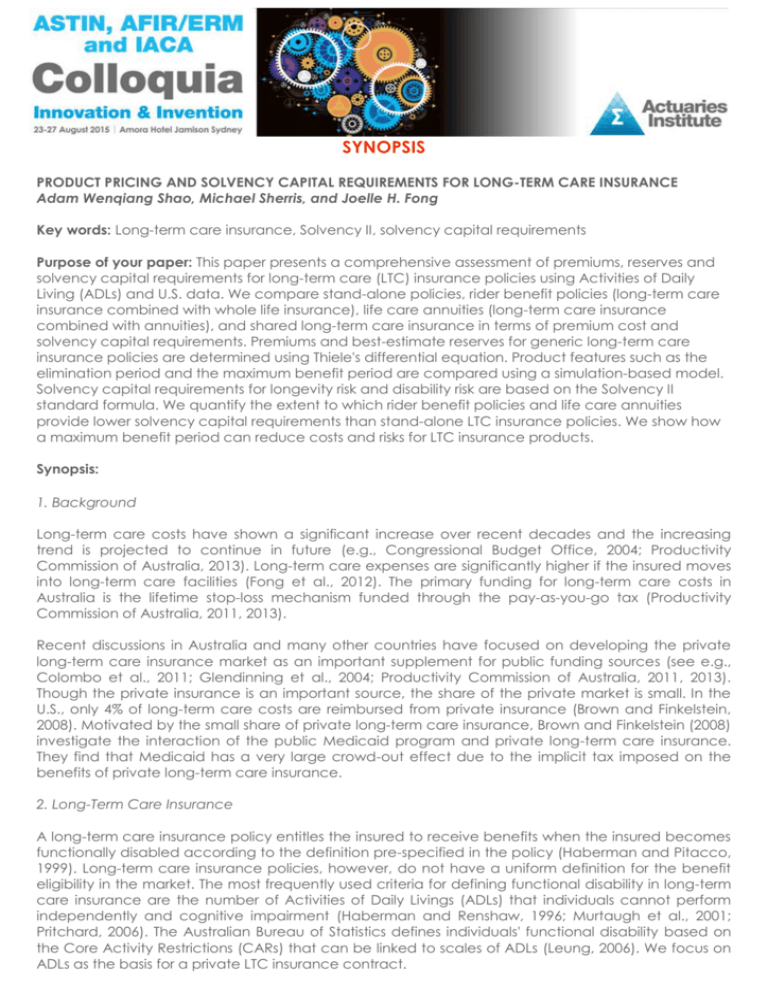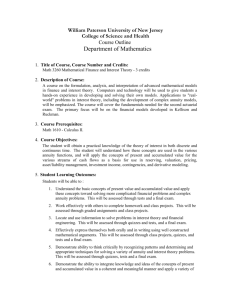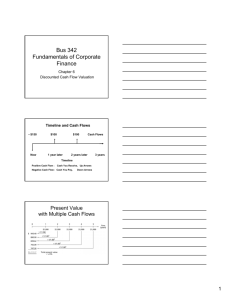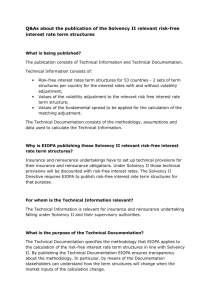Product Pricing and Solvency Capital Requirements for Long
advertisement

SYNOPSIS PRODUCT PRICING AND SOLVENCY CAPITAL REQUIREMENTS FOR LONG-TERM CARE INSURANCE Adam Wenqiang Shao, Michael Sherris, and Joelle H. Fong Key words: Long-term care insurance, Solvency II, solvency capital requirements Purpose of your paper: This paper presents a comprehensive assessment of premiums, reserves and solvency capital requirements for long-term care (LTC) insurance policies using Activities of Daily Living (ADLs) and U.S. data. We compare stand-alone policies, rider benefit policies (long-term care insurance combined with whole life insurance), life care annuities (long-term care insurance combined with annuities), and shared long-term care insurance in terms of premium cost and solvency capital requirements. Premiums and best-estimate reserves for generic long-term care insurance policies are determined using Thiele's differential equation. Product features such as the elimination period and the maximum benefit period are compared using a simulation-based model. Solvency capital requirements for longevity risk and disability risk are based on the Solvency II standard formula. We quantify the extent to which rider benefit policies and life care annuities provide lower solvency capital requirements than stand-alone LTC insurance policies. We show how a maximum benefit period can reduce costs and risks for LTC insurance products. Synopsis: 1. Background Long-term care costs have shown a significant increase over recent decades and the increasing trend is projected to continue in future (e.g., Congressional Budget Office, 2004; Productivity Commission of Australia, 2013). Long-term care expenses are significantly higher if the insured moves into long-term care facilities (Fong et al., 2012). The primary funding for long-term care costs in Australia is the lifetime stop-loss mechanism funded through the pay-as-you-go tax (Productivity Commission of Australia, 2011, 2013). Recent discussions in Australia and many other countries have focused on developing the private long-term care insurance market as an important supplement for public funding sources (see e.g., Colombo et al., 2011; Glendinning et al., 2004; Productivity Commission of Australia, 2011, 2013). Though the private insurance is an important source, the share of the private market is small. In the U.S., only 4% of long-term care costs are reimbursed from private insurance (Brown and Finkelstein, 2008). Motivated by the small share of private long-term care insurance, Brown and Finkelstein (2008) investigate the interaction of the public Medicaid program and private long-term care insurance. They find that Medicaid has a very large crowd-out effect due to the implicit tax imposed on the benefits of private long-term care insurance. 2. Long-Term Care Insurance A long-term care insurance policy entitles the insured to receive benefits when the insured becomes functionally disabled according to the definition pre-specified in the policy (Haberman and Pitacco, 1999). Long-term care insurance policies, however, do not have a uniform definition for the benefit eligibility in the market. The most frequently used criteria for defining functional disability in long-term care insurance are the number of Activities of Daily Livings (ADLs) that individuals cannot perform independently and cognitive impairment (Haberman and Renshaw, 1996; Murtaugh et al., 2001; Pritchard, 2006). The Australian Bureau of Statistics defines individuals' functional disability based on the Core Activity Restrictions (CARs) that can be linked to scales of ADLs (Leung, 2006). We focus on ADLs as the basis for a private LTC insurance contract. A stand-alone policy pays out the predetermined benefit when the insured becomes functionally disabled. In practice LTC policies can be combined with other forms of insurance. Long-term care cover included as a rider benefit in a whole life insurance policy, referred to as the rider benefit policy, is a financial product that allows the insured to draw the death benefit for long-term care costs before death (Haberman and Pitacco, 1999). Long-term care insurance can also be combined with annuities, which is usually referred to as the life care annuity (Brown and Warshawsky, 2013; Murtaugh et al., 2001; Warshawsky, 2007). The life care annuity reduces the adverse selection problem by pooling annuitants who are vulnerable to longevity risk and long-term care insurance policyholders who are vulnerable to disability risk (Murtaugh et al., 2001). This risk pooling of the life care annuity provides a natural hedge and therefore reduces insurance premiums (Murtaugh et al., 2001; Warshawsky, 2007). Insurers usually include an elimination period and a maximum benefit period in the product. The elimination period is the required minimum number of consecutive payment periods before the insured becomes eligible for benefits. The maximum benefit period is the maximum periods of payment that the insured can possibly receive. A generic long-term care insurance in this paper refers to a long-term care insurance policy with an elimination period of zero and an unlimited maximum benefit period. 3. Key Results This paper has assessed premiums, best-estimate reserves and solvency capital requirements for a broad range of long-term care insurance policies sold to individuals in different health states. Thiele's differential equation approach and a simulation-based method are applied to a range of policy designs. Long-term care insurance policies considered are stand-alone policies, rider benefit policies (long-term care insurance combined with whole life insurance), life care annuities (long-term care insurance combined with annuities), and shared long-term care insurance. Policies providing reasonable levels of fixed benefits are relatively affordable for healthy lives. Whereas premiums of stand-alone policies are very high for disabled and older individuals, in particular for those who are severely disabled, life care annuities that combine long-term care insurance and annuities are more affordable for disabled and older individuals as well as for healthy lives. Policy design can be used to enhance the insurability of long-term care expenses for individuals with impaired health. The simulation-based approach is required to assess premiums and reserves for policies with different combinations of elimination periods and maximum benefit periods. This also allows the distributional measures of future liabilities, such as the VaR, to be estimated. The elimination period and maximum benefit period are shown to be effective in making a LTC product more affordable. The maximum benefit period is effective in reducing idiosyncratic risk arising from reduced numbers of policies at the older ages. The Solvency II standard formula framework shows that solvency capital requirements are high for long-term care insurance taking into account both longevity risk and disability risk. Stand-alone policies issued to the more disabled require less capital per unit premium compared to healthy lives. Interestingly rider benefit policies and life care annuities show substantial reductions in the required capital per premium compared to stand-alone long-term care insurance reinforcing the potential benefits of these products. We have provided a thorough analysis of premiums, reserves and capital of LTC polices. We have used US individual data to provide mortality and disability assumptions to allow a realistic assessment. The analysis presented provides valuable insights into the product design of more affordable products and an analysis of the solvency risks faced by long-term care insurance providers. References Brown, J. and Warshawsky, M. (2013). The life care annuity: A new empirical examination of an insurance innovation that addresses problems in the markets for life annuities and long-term care insurance. Journal of Risk and Insurance, 80(3), 677-704. Brown, J. R. and Finkelstein, A. (2008). The interaction of public and private insurance: Medicaid and the long-term care insurance market. American Economic Review, 98(3), 1083-1102. Colombo, F., Llena-Nozal, A., Mercier, J., and Tjadens, F. (2011). Help wanted? Providing and paying for long-term care. OECD Health Policy Studies. OECD Publishing, Paris, France. Congressional Budget Office (2004). Financing long-term care for the elderly. Available at http://www.cbo.gov/publication/15584. Fong, J. H., Koh, B. S., and Mitchell, O. S. (2012). Functional disabilities and nursing home admittance. Pension Research Council Working Paper No. 2012-19. Glendinning, C., Davies, B., Pickard, L., and Comas-Herrera, A. (2004). Funding long-term care for older people: Lessons from other countries. Joseph Rowntree Foundation, York, U.K. Haberman, S. and Pitacco, E. (1999). Actuarial models for disability insurance. Chapman and Hall/CRC Press Inc, Boca Raton, U.S. Haberman, S. and Renshaw, A. E. (1996). Generalized linear models and actuarial science. The Statistician, 45(4), 407-436. Leung, E. (2006). A multiple state model for pricing and reserving private long term care insurance contracts in Australia. Australian Actuarial Journal, 12(2), 187-247. Murtaugh, C. M., Spillman, B. C., and Warshawsky, M. J. (2001). In sickness and in health: An annuity approach to financing long-term care and retirement income. Journal of Risk and Insurance, 68(2), 225-254. Pritchard, D. J. (2006). Modeling disability in long-term care insurance. North American Actuarial Journal, 10(4), 48-75. Productivity Commission of Australia (2011). Caring for older Australians. Final Inquiry Report No. 53. Available at http://www.pc.gov.au/projects/inquiry/aged-care/report. Productivity Commission of Australia (2013). An ageing Australia: Preparing for the future. Commission Research Paper. Available at http://www.pc.gov.au/__data/assets/pdf_ile/0005/129749/ageingaustralia.pdf. Warshawsky, M. J. (2007). The life care annuity - A proposal for an insurance product innovation to simultaneously improve financing and benefit provision for long-term care and to insure the risk of outliving assets in retirement. Georgetown University Long-Term Care Financing Project Working Paper No. 2.








